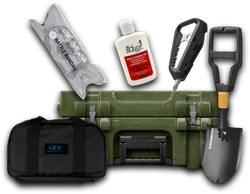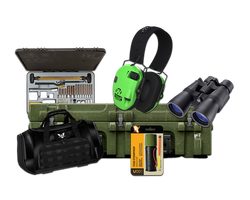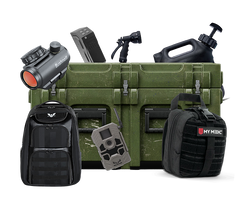When Was the Bolt Action Rifle Invented: A Comprehensive History
Table of Contents
- Introduction
- The Origins of the Bolt Action Rifle
- Key Innovations and Historical Milestones
- The Transition from Military to Civilian Use
- The Anatomy of a Bolt-Action Rifle
- The Enduring Legacy of the Bolt-Action Rifle
- Conclusion
- FAQ
Introduction
Imagine standing on the battlefield of the 19th century, surrounded by the cacophony of gunfire and the chaos of war. Soldiers were transitioning from slow-loading muzzleloaders to more advanced firearms that would change the dynamics of combat forever. Among these innovations, the bolt-action rifle emerged as a revolutionary tool, allowing for faster reloading and increased accuracy. But when was the bolt action rifle invented, and how did it evolve to become the standard infantry weapon for many armies across the globe?
The first bolt-action rifle was introduced in the early 19th century, and its development has influenced military engagements and civilian use for decades. This blog post will delve into the fascinating history of the bolt-action rifle, exploring its origins, technological advancements, and the reasons behind its enduring popularity. By the end of this article, you will have a comprehensive understanding of the bolt-action rifle's significance in military history, its design variations, and its modern applications.
We will cover a variety of topics, including:
- The origins and early designs of bolt-action rifles
- Key innovations and historical milestones
- The role of bolt-action rifles in military conflicts
- The transition from military to civilian use
- Modern bolt-action rifles and their applications
Let’s embark on this journey through time to understand the legacy of the bolt-action rifle and its impact on the world of firearms.
The Origins of the Bolt Action Rifle
The Early Designs
The history of the bolt-action rifle can be traced back to the early 1800s. The first significant development in this area came in 1824 when Johann Nikolaus von Dreyse, a German inventor, created the needle gun, known as the Dreyse rifle. This rifle utilized a breech-loading system that allowed soldiers to load ammunition from the rear rather than the front, dramatically increasing the rate of fire. By 1836, Dreyse perfected his design, leading to the introduction of the "Nadelgewehr," or needle rifle, which was adopted by the Prussian Army in 1841.
Advancements in Technology
The design of bolt-action rifles continued to evolve throughout the mid-19th century. In 1855, an early repeating bolt-action rifle was patented in Britain, which utilized a gravity-operated tubular magazine. This laid the groundwork for future developments in bolt-action technology. Notably, the 1866 Chassepot rifle became the first widely adopted bolt-action rifle by a military force, showcasing the practical advantages of this design.
As military conflicts such as the American Civil War unfolded, bolt-action rifles began to gain traction. The Palmer Carbine, developed in 1863, was one of the first bolt-action firearms used by Union cavalry. However, it was not until the late 19th century that bolt-action rifles would become the dominant infantry weapon.
Key Innovations and Historical Milestones
The Rise of Bolt-Action Rifles
The late 19th century marked a pivotal moment for bolt-action rifles, particularly with the introduction of the Krag-Jørgensen rifle in 1892. This design was adopted by the U.S. Army and featured a horizontal box magazine, allowing for quicker loading and reloading. The Krag's smooth action and reliability made it a favorite among soldiers, even as military leaders recognized the need for further advancements.
The Mauser System
One of the most significant innovations in bolt-action rifle design came from the Mauser family of rifles. The Gewehr 98, introduced in 1898, became a benchmark for bolt-action technology. It featured a strong, rotating bolt that provided improved locking and extraction. The Mauser system's design principles influenced countless other rifles, establishing the standard for accuracy and reliability.
During World War I, bolt-action rifles were the primary infantry weapons for most combatant countries, including Germany, Britain, and France. The British Lee-Enfield rifle, with its ten-round magazine, became synonymous with the British Army, offering rapid-fire capabilities and reliability in the trenches.
World War I and Its Aftermath
The use of bolt-action rifles peaked during World War I, where soldiers relied on these firearms for both offense and defense. The overwhelming demand for accurate, reliable rifles influenced manufacturers to produce vast quantities of bolt-action designs, leading to innovations in materials and manufacturing techniques.
The interwar years saw bolt-action rifles continuing to dominate military arsenals, but the advent of semi-automatic technology began to shift the landscape. The U.S. Army's adoption of the M1 Garand during World War II marked a significant transition away from bolt-action rifles as the primary infantry weapon.
The Transition from Military to Civilian Use
Bolt-Action Rifles in Hunting
Despite the rise of semi-automatic rifles, bolt-action designs did not disappear; rather, they found a new life in civilian applications. Hunters and sport shooters appreciated the accuracy and reliability that bolt-action rifles offered. This transition was marked by the introduction of various models tailored for hunting and target shooting.
The popularity of .22 caliber bolt-action rifles, such as the Winchester Model 52, made them accessible to the general public. Their affordability and ease of use made them ideal for teaching new shooters the fundamentals of marksmanship.
Modern Bolt-Action Rifles
Today, bolt-action rifles remain a staple in both the hunting and competitive shooting communities. Modern advancements have led to the development of sophisticated designs that incorporate lightweight materials, precision engineering, and ergonomic features. Manufacturers continue to produce a wide range of bolt-action rifles suitable for various applications, from hunting large game to precision shooting in competitions.
For those interested in exploring high-quality bolt-action rifles, Crate Club offers a curated selection of tactical gear tailored for enthusiasts and survivalists. Whether you’re a seasoned marksman or just starting your journey, Crate Club provides access to quality gear that enhances your readiness and capabilities.
The Anatomy of a Bolt-Action Rifle
Key Components
Understanding the key components of a bolt-action rifle is crucial for appreciating its design and functionality. The main components include:
-
Bolt: The heart of the bolt-action mechanism, responsible for locking the cartridge in the chamber and enabling extraction of spent casings. The bolt typically features lugs that lock into the receiver for added security.
-
Receiver: The part of the rifle that houses the bolt and connects various components. It serves as the foundation for the entire action.
-
Trigger: This mechanism releases the firing pin, initiating the firing sequence. Modern rifles often feature adjustable triggers for enhanced precision.
-
Magazine: Bolt-action rifles can be fed by internal or detachable magazines. Internal magazines are often flush with the rifle's stock, while detachable magazines allow for faster reloading.
-
Barrel: The barrel focuses the bullet's trajectory and is critical for accuracy. Modern bolts may feature precision-engineered barrels to enhance performance.
Operation Mechanism
The bolt-action mechanism operates through a series of steps:
- Unlocking the Bolt: The shooter lifts the bolt handle, rotating it to unlock the bolt from the receiver.
- Pulling Back the Bolt: The shooter pulls the bolt back to extract the spent cartridge.
- Chambering a New Round: Pushing the bolt forward chambers a new round from the magazine.
- Locking the Bolt: The shooter rotates the bolt handle down to lock the bolt in place, ensuring the rifle is ready to fire.
This straightforward yet effective mechanism allows for controlled loading and ejection, making bolt-action rifles favored for their accuracy and reliability.
The Enduring Legacy of the Bolt-Action Rifle
Military Applications Today
Although the military landscape has shifted significantly with the introduction of semi-automatic and automatic firearms, bolt-action rifles continue to play a crucial role, particularly in specialized applications such as sniper operations. The design’s inherent accuracy and reliability make it ideal for long-range engagements, where precision is paramount.
Bolt-Action Rifles in Competitive Shooting
Competitive shooting disciplines, such as precision rifle competitions and biathlon events, still heavily utilize bolt-action rifles. The accuracy and control offered by bolt actions allow shooters to excel in these high-stakes environments.
A Community of Enthusiasts
The bolt-action rifle has cultivated a dedicated community of enthusiasts and collectors. Events, forums, and clubs exist to celebrate the craftsmanship and history of these firearms. Whether through hunting, competition, or historical reenactments, the bolt-action rifle continues to be cherished by many.
For those looking to join this community or enhance their gear collection, Crate Club offers subscription services that deliver curated tactical gear, survival tools, and equipment directly to your door. Explore the various subscription tiers that cater to different levels of experience, from beginners to seasoned tacticians, to find the right fit for your needs.
Conclusion
From its inception in the early 19th century to its present-day applications, the bolt-action rifle has proven to be a significant innovation in firearms history. Its evolution reflects advancements in technology, military strategy, and civilian use, making it a versatile weapon that has stood the test of time.
As we’ve explored, the bolt-action rifle's design offers a unique combination of reliability, accuracy, and simplicity. Whether in the hands of a soldier on the battlefield or a hunter in the field, these rifles continue to serve a vital role in firearms culture.
If you’re considering adding a bolt-action rifle to your collection or enhancing your tactical gear, look no further than Crate Club's subscription services and shop, which provide access to high-quality gear tailored for enthusiasts.
FAQ
When was the first bolt-action rifle invented?
The first bolt-action rifle was invented in 1824 by Johann Nikolaus von Dreyse, with his needle rifle being adopted by the Prussian Army in 1841.
What advantages do bolt-action rifles have over other types of firearms?
Bolt-action rifles offer superior accuracy, reliability, and simplicity. Their design allows for controlled loading and ejection, making them ideal for precision shooting and hunting.
Are bolt-action rifles still used in modern military applications?
Yes, bolt-action rifles are still used today, particularly for sniper roles due to their accuracy and reliability in long-range engagements.
Can bolt-action rifles be used for hunting?
Absolutely! Bolt-action rifles are widely used for hunting various game, from small animals to large game, thanks to their precision and reliability.
Where can I find high-quality bolt-action rifles and gear?
You can explore Crate Club’s subscription services and shop for curated tactical gear and high-quality firearms. Check out the Crate Club Subscription Services here and visit the Crate Club Shop here.
Join the ranks of tactical enthusiasts and elevate your preparedness with the right gear to enhance your skills and experience.
Share this article



